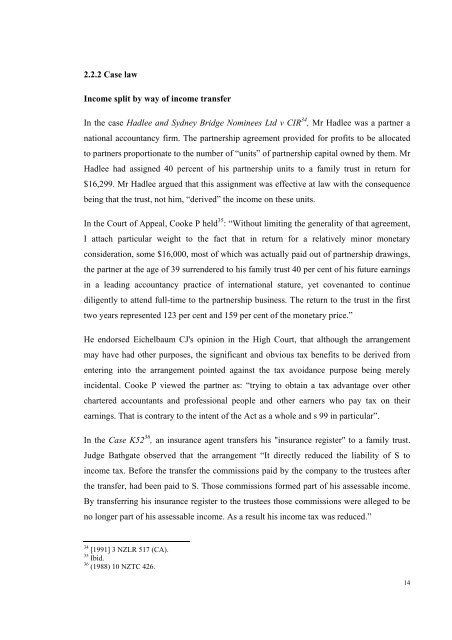Tax Avoidance: Causes and Solutions - Scholarly Commons Home
Tax Avoidance: Causes and Solutions - Scholarly Commons Home
Tax Avoidance: Causes and Solutions - Scholarly Commons Home
You also want an ePaper? Increase the reach of your titles
YUMPU automatically turns print PDFs into web optimized ePapers that Google loves.
2.2.2 Case law<br />
Income split by way of income transfer<br />
In the case Hadlee <strong>and</strong> Sydney Bridge Nominees Ltd v CIR 34 , Mr Hadlee was a partner a<br />
national accountancy firm. The partnership agreement provided for profits to be allocated<br />
to partners proportionate to the number of “units” of partnership capital owned by them. Mr<br />
Hadlee had assigned 40 percent of his partnership units to a family trust in return for<br />
$16,299. Mr Hadlee argued that this assignment was effective at law with the consequence<br />
being that the trust, not him, “derived” the income on these units.<br />
In the Court of Appeal, Cooke P held 35 : “Without limiting the generality of that agreement,<br />
I attach particular weight to the fact that in return for a relatively minor monetary<br />
consideration, some $16,000, most of which was actually paid out of partnership drawings,<br />
the partner at the age of 39 surrendered to his family trust 40 per cent of his future earnings<br />
in a leading accountancy practice of international stature, yet covenanted to continue<br />
diligently to attend full-time to the partnership business. The return to the trust in the first<br />
two years represented 123 per cent <strong>and</strong> 159 per cent of the monetary price.”<br />
He endorsed Eichelbaum CJ's opinion in the High Court, that although the arrangement<br />
may have had other purposes, the significant <strong>and</strong> obvious tax benefits to be derived from<br />
entering into the arrangement pointed against the tax avoidance purpose being merely<br />
incidental. Cooke P viewed the partner as: “trying to obtain a tax advantage over other<br />
chartered accountants <strong>and</strong> professional people <strong>and</strong> other earners who pay tax on their<br />
earnings. That is contrary to the intent of the Act as a whole <strong>and</strong> s 99 in particular”.<br />
In the Case K52 36 , an insurance agent transfers his "insurance register" to a family trust.<br />
Judge Bathgate observed that the arrangement “It directly reduced the liability of S to<br />
income tax. Before the transfer the commissions paid by the company to the trustees after<br />
the transfer, had been paid to S. Those commissions formed part of his assessable income.<br />
By transferring his insurance register to the trustees those commissions were alleged to be<br />
no longer part of his assessable income. As a result his income tax was reduced.”<br />
34<br />
[1991] 3 NZLR 517 (CA).<br />
35<br />
Ibid.<br />
36<br />
(1988) 10 NZTC 426.<br />
14

















